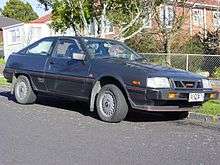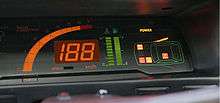Mitsubishi Cordia
| Mitsubishi Cordia | |
|---|---|
_GSL_hatchback_(2009-09-17).jpg) | |
| Overview | |
| Manufacturer | Mitsubishi Motors |
| Production | 1982–1990 |
| Assembly | Okazaki, Aichi, Japan (Nagoya Plant) |
| Body and chassis | |
| Class | Sport compact |
| Body style | 3-door liftback coupé |
| Layout |
Front-engine, front-wheel-drive Front-engine, four-wheel-drive |
| Platform | A211A-A213A |
| Related | Mitsubishi Tredia, Mitsubishi Starion |
| Powertrain | |
| Engine |
1.4 L 4G12T I4 (gasoline) 1.6 L 4G32 I4 (gasoline) 1.6 L 4G32T I4-T (gasoline) 4G37 l4 (gasoline) 1.8 L 4G62 I4 (gasoline) 1.8 L 4G62T I4-T (gasoline) 2.0 L 4G63 I4 (gasoline) |
| Transmission |
2×4-speed Super Shift manual 5-speed manual 3-speed automatic 4-speed automatic |
| Dimensions | |
| Wheelbase | 2,445 mm (96.3 in) |
| Length | 4,275 mm (168.3 in) |
| Width | 1,660 mm (65.4 in) |
| Height | 1,320 mm (52.0 in) |
| Curb weight | 905–960 kg (1,995–2,116 lb) |
| Chronology | |
| Predecessor | Mitsubishi Lancer Celeste |
| Successor | Mitsubishi Eclipse |
The Mitsubishi Cordia is a compact hatchback-coupé manufactured by Mitsubishi Motors between 1982 and 1990. Alongside the Tredia and Starion, the Cordia is one of the first cars imported and sold in the United States by Mitsubishi without the help of Chrysler Corporation, which owned a stake in Mitsubishi and sold its models as captive imports. The Cordia XP was the model sold at the Japanese Car Plaza retail chain, while the Cordia XG was sold at the Galant Shop chain. The Cordia XG model had a somewhat smaller front grill.
The Cordia was one of the first mass-market cars to offer an optional electronic instrument cluster.
Overview


Offered between the existing Mitsubishi Galant and Lancer models, the Cordia (along with the Tredia) used the front-wheel drive and was similar in design to the Mirage, with the exception of its larger size. Mitsubishi incorporated MacPherson strut/beam axle suspension, front disc brakes, manual or automatic transmission, and a choice of three engines: a 68 hp 1.4-litre, a 74–87 hp (55–65 kW) 1.6-litre, and a 112 hp (84 kW) turbocharged 1.6-litre engine. Some export markets also received a carb-fed 110 hp (82 kW) 1.6-litre. A US version of the 2.0-litre generated 88 hp for the 1984 model.
The cars received a mild facelift in 1983 and the option of four-wheel drive was offered in 1984. The engines were modified in 1985 to allow the cars to run on unleaded fuel with the introduction of a 1.8-litre engine in both 100 hp (70 kW) naturally aspirated and 135 hp (101 kW) turbocharged form. The Cordia sold in the United States throughout 1988 until manufacturing was discontinued in 1990.
In Australia, the Cordia AA series was released in late 1983. An update, titled AB Series, arrived with a different grille and other minor changes in 1984. The final AC model was upgraded to unleaded fuel in late 1985. Production ceased in 1988.[1] Two trim levels were available, the naturally aspirated 1.8-litre GSL and the turbocharged GSR.[2][3] The early (leaded) GSRs were fitted with 13-inch alloy wheels; unleaded cars came fitted with chrome alloy 14-inch wheels.[1] The 1800 Coridias were considered good performers in the Australian market, particularity the turbo, which produced 110 kW [4], until both engines were modified to meet emission standards which markedly reduced the power of both the GSR and GSL. The GSR was used as a pursuit car by NSW Police and later become a cult car with some enthusiasts.
Mitsubishi made an effort for the Cordia to compete with, most notably, the Toyota AE86 and the Nissan Silvia S12, by upgrading the old 1.6 motor to 1.8 models, but the 1.8 was still quite underpowered as they refused to make it with DOHC. Mitsubishi had been wasting money with the failing Tredia and putting more money into the Starion, ending in a financial bind. Mitsubishi's strategy became a flop as they poured money into the Starion, which did not appeal to the export market due to Mitsubishi's status as a new brand to customers in the US, the fact it was no longer rebadged as a Chrysler, and their poor marketing techniques; this led to the demise of Mitsubishi's three-pronged attack on the export market, and sales were slow in Japan for similar reasons.
In New Zealand the Cordia was assembled, with the Tredia that it is based on, first by Todd Motors, and later by Mitsubishi New Zealand. The cars were imported as CKD kits and were built with about 41% local content including glass, upholstery, carpet, wiring harnesses and radiators. Both naturally aspirated engine models and turbocharged versions were made.
References
- 1 2 Knowling, Michael (10 November 1998). "Pre-Owned Performance – Mitsubishi Cordia Turbo". AutoSpeed. Archived from the original on 13 October 2008.
- ↑ "Mitsubishi Cordia". Unique Cars and Parts. Retrieved 20 June 2016.
- ↑ Drach, Michael (1997). "Cordia Specifications". Cordia Turbo.com. Retrieved 20 June 2016.
- ↑ https://www.redbook.com.au/cars/details/1984-mitsubishi-cordia-gsr-ab-manual/SPOT-ITM-259985/
External links
- Official history of the Cordia & Tredia, Mitsubishi Motors South Africa website
- Specifications for Mitsubishi vehicles at Carfolio.com
Mitsubishi automobile timeline, North American market, 1980s–present | |||||||||||||||||||||||||||||||||||||||
|---|---|---|---|---|---|---|---|---|---|---|---|---|---|---|---|---|---|---|---|---|---|---|---|---|---|---|---|---|---|---|---|---|---|---|---|---|---|---|---|
| Type | 1980s | 1990s | 2000s | 2010s | |||||||||||||||||||||||||||||||||||
| 0 | 1 | 2 | 3 | 4 | 5 | 6 | 7 | 8 | 9 | 0 | 1 | 2 | 3 | 4 | 5 | 6 | 7 | 8 | 9 | 0 | 1 | 2 | 3 | 4 | 5 | 6 | 7 | 8 | 9 | 0 | 1 | 2 | 3 | 4 | 5 | 6 | 7 | 8 | |
| Subcompact | Precis | i-MiEV | i-MiEV | ||||||||||||||||||||||||||||||||||||
| Mirage | Mirage | Mirage | Mirage | Mirage | |||||||||||||||||||||||||||||||||||
| Tredia | G4 | ||||||||||||||||||||||||||||||||||||||
| Compact | Mirage | Lancer | Lancer | ||||||||||||||||||||||||||||||||||||
| Galant | Galant | Galant | |||||||||||||||||||||||||||||||||||||
| Sigma | Diamante | ||||||||||||||||||||||||||||||||||||||
| Mid-size | Galant | Galant | |||||||||||||||||||||||||||||||||||||
| Diamante | |||||||||||||||||||||||||||||||||||||||
| Sport compact | Cordia | Eclipse | Eclipse | Eclipse | Eclipse | ||||||||||||||||||||||||||||||||||
| Lancer Evolution | Lancer Evolution | ||||||||||||||||||||||||||||||||||||||
| Sports car | Starion | 3000GT | |||||||||||||||||||||||||||||||||||||
| Compact MPV | Expo LRV | ||||||||||||||||||||||||||||||||||||||
| Large MPV | Space Wagon | Expo | |||||||||||||||||||||||||||||||||||||
| Minivan | Vanwagon | ||||||||||||||||||||||||||||||||||||||
| Compact crossover | Outlander Sport / RVR | ||||||||||||||||||||||||||||||||||||||
| Eclipse Cross | |||||||||||||||||||||||||||||||||||||||
| Mid-size crossover | Outlander | Outlander | Outlander | ||||||||||||||||||||||||||||||||||||
| Endeavor | |||||||||||||||||||||||||||||||||||||||
| Mid-size SUV | Montero Sport | Montero Sport | Montero Sport | ||||||||||||||||||||||||||||||||||||
| Full-size SUV | Montero | Montero | Montero | Montero | |||||||||||||||||||||||||||||||||||
| Pickup | Mighty Max | Mighty Max | Raider | L200 | L200 | ||||||||||||||||||||||||||||||||||
| Vehicle is not available in the United States or Canada | |||||||||||||||||||||||||||||||||||||||